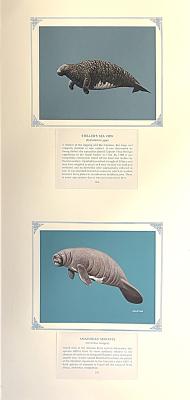PAINTINGS - (a) RIGHT WHALE & (b) BOWHEAD WHALE
c. 19752 paintings in single framed work (a) Right Whale - large bodied, stocky, black with white patches on the under belly , no dorsal fin, crustaceans on arched mouth and head (51) (b) Bowhead Whale - large bodied with head extending one third of the body, curved mouth, black with white under lip and no dorsal fin (52); gouache on blue card, framed and mounted with inscription
Collection of 106 of paintings by Richard Ellis that were selected by the Smithsonian Institution to form a traveling exhibit of the marine mammals of the world. The collection was purchased by Perth businessman Kevin Parry in 1985 and donated to Whale World, now known as Albany's Historic Whaling Station.
Details
Details
RIGHT WHALE (Balaena glacialis)
Because it produced plentiful oil and bone, was slow swimming and easy to kill, and floated when dead, this animal became known as the "right" whale to hunt. Right whales are thickset, heavy animals with no dorsal fin. They have been measured at up to 60 feet, and may weigh as many tons. They have extremely long baleen plates , and feed by " skimming" through shoals of small crustaceans. The whales are born with the "callosities" on their heads; the pattern of these callosities varies, making possible the identification of individual whales. The largest breeding population of these rare whales is found off the Patagonian coast of southern Argentina, but they are protected throughout the world.
51.
BOWHEAD WHALE (Balaena mysticetus)
Probably the rarest large animal in the world, the bowhead is certainly the largest rare animal in the world. It is a heavy bodied whale with a head that can account for a third of its 60-foot length. This species has the longest baleen plates of any whale, sometimes measured at 15 feet or more. Also known as " whalebone," baleen was used for corset stays, skirt hoops, and buggy whips, and was the reason this whale was so intensively hunted. In the 17th and 18th centuries, the bowhead (then known as the "Greenland right whale or the "Arctic whale") was hunted to extinction in the eastern Arctic; the only remaining population today can be found off Alaska. There are fewer than 3000 bowheads alive now, and the Alaskan Eskimos still hunt them for food and blubber.
52.
Verso: Smithsonian label checklist # 51,52 Packing case # 2, AWHS accession number
The paintings represent a body of work by well-known American marine conservationist, author, artist and natural historian Richard Ellis (1938-2024).
Copyright and Reference
Copyright and Reference
Albany's Historic Whaling Station
Albany's Historic Whaling Station
Other items by Richard Ellis
- PAINTING - FINLESS PORPOISE
- PAINTING - ATLANTIC WHITE SIDED DOLPHIN
- PAINTING - ROSS SEAL
- PAINTINGS - (a)PYGMY SPERM WHALE (b)DWARF SPERM WHALE
- PAINTING - COMMON DOPLHIN
- PAINTINGS - (a) BAIRD'S BEAKED WHALE (b) GOOSEBEAK WHALE
- PAINTINGS - (a)SPECTACLED PORPOISE (b)BURMEISTER'S PORPOISE
- PAINTING -BEARDED SEAL
- PAINTINGS - (a)FRASER'S DOLPHIN & (b)WHITE BEAKED DOLPHIN
- PAINTING - SOUTHERN LION SEAL
- PAINTING - (a) Steller's Sea Cow (b) Amazonian Manatee
- PAINTING - HEAVISIDE'S DOLPHIN
More items like this
Other items from Albany's Historic Whaling Station
- PAINTING - HUMPBACK WHALE
- PAINTING - SPERM WHALE
- PAINTING - PYGMY RIGHT WHALE
- PAINTING - KILLER WHALE
- PAINTING - HECTOR'S BEAKED WHALE
- PAINTING - ARCH BEAKED WHALE
- PAINTINGS OF (a)BELUGA & (b)NARWHAL
- PAINTING - COMMERSON'S DOLPHIN
- PAINTING - DUGONG
- PAINTING - POLAR BEAR
- PAINTING - SEA OTTER
- PAINTING - RISSO'S DOLPHIN

